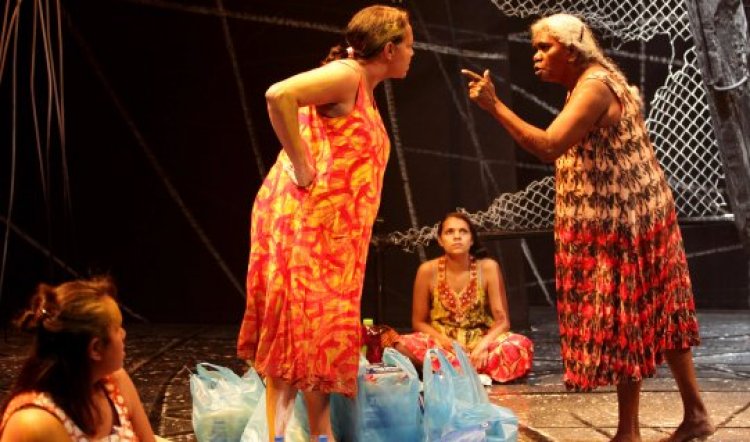
BLOODLAND
BLOODLAND Wharf 1. Sydney Theatre Company, Adelaide Festival and Allens Arthur Robinson in association with Bangarra Dance Theatre; 7 October–13 November 2011. Photos Danielle Lyonne, main pic Elaine Crombie, Tessa Rose, Rarriwuy Hick and Kathy Balngayngu Marika; right: Ursula Yovich.
BLOODLAND is a journey into a new kind of Australian theatre work by indigenous artists, Stephen Page, Kathy Balngayngu Marika and Wayne Blair. It’s an uneasy combination of hip urban-indigenous, traditional Arnhem Land and the long-developed Bangarra style of ancient-modern dance-performance. It’s performed in the Yolgnu language and there are deliberately few signposts for non-speakers. The story strands are clear and visual however, and catching on isn’t too difficult as these stories are on the basic side.
A central theme is the love story between two young people whose “wrong skin” moiety status is as ill-fated and inevitable as if their last names were Montagu and Capulet. Similarly, the youthful sass of the city, represented by Kelton Pell as Billy, runs headlong into the weight and dignity of the traditional law man Djurrpun (Banula Marika).
By way of something approaching contrast, there is also some clichèd malarkey among the women with damper dough, many bottles of water and other domestic drama of the kind wheeled about in supermarket trolleys and accompanied by hearty arguing. There are also some sort-of dance moves: much prowling about on the crouch and occasional ’roo hopping and muzzle-scratching.
This show reminded me of the early days of feminist theatre. Back then it was politically unacceptable to be even mildly critical or unenthusiastic; positive reinforcement and positive views were mandatory, no matter what. I can say positively that the piece is rendered with verve, sincerity and the considerable talents of the principal creatives and cast of Elaine Crombie, Rarriwuy Hicks, Rhimi Johnson Page, Banula Marika, Nolene Marika, David Page, Hunter Page Lochard, Kelton Pell, Tessa Rose, Meyne Wyatt and Ursula Yovich but it’s not enough; at least not for me; and not now after 20+ years of Bangarra and even longer since Ernie Dingo asked a Downstairs Belvoir audience if they could say “yes” in a number of European languages (of course they could). He then provoked uneasy laughter when he asked if they could say “yes” in any Aboriginal languages. On the other hand, can Arrente speakers fully understand Yolngu? How about Wiradjuri or Noongar?
Alienation is a curious thing, particularly in theatre, as Brecht (and others) knew well. It can be exciting, thought provoking, disconcerting and even aggressive. Laughter has a similar capacity, when it comes from members of an audience. Although there was little to laugh at, in the opening night crowd there were a number of people who laughed uproariously in the oddest places; in the way people do when they want others to know they “get it”. They’re like the insufferables at rock concerts who do a similar thing with noisy whoops of apparent recognition or knowing little bursts of clapping at the opening chord of each song. It often has the effect of even further alienating the already marginalized – which is rather piquant when the show is about alienation and marginalization anyway. Perhaps that’s part of the point.

You’ll have gathered by now that Bloodland did little for me; and perhaps that’s another part of the point. Many indigenous Australians spend most of their lives feeling left out, angry, disrespected and disregarded, so what’s an hour and 40 minutes of very mild forms of these sensations? Maybe that’s the point too. But there are other points to be made: Bloodland might be eye-opening and interesting, even shocking, for someone seeing their first, or a rare, black theatre event; otherwise it was – for me – repetitive, trite and unoriginal.
From a theatrical, rather than political or social, viewpoint, the best aspects of the show are the set by Peter England, lighting, by Damien Cooper and composer/sound designer Steve Francis’s work. But you know you’re in trouble when that’s the case. There are moments and ideas of great beauty and poignancy, in particular, Ursula Yovich is an unnerving and tragic figure with her placky bag of discarded mobile phones and the disturbance of her mind.
The evening ends with a ritualized funeral, seemingly in real time, of the Romeo figure in the blighted love affair. It was a final note of estrangement for me because although it was clearly supposed to be a tragedy, I was past caring. All I could think, as I stared at the corpse was, where is the next Jack Davis? The new No Sugar or Kullark? Surely there are better works than this in the pipeline?



